MAIL ORDER RIFLE
by John Armstrong
According to the Warren Commission Lee HARVEY Oswald left his job at Jaggers-Chiles-Stovall on the morning of March 12, walked 9 blocks to the downtown post office, purchased a postal money order, and then mailed the money order to Klein's Sporting Goods in Chicago. But the letter was postmarked 10:30 am, while company time records show that Oswald never left his job. He worked continuously from 8:00 am through 12:15 pm on 9 different printing jobs.
The Warren Commission never pointed out that the letter to Klein's was time stamped 10:30 am, while company time records showed that Oswald never left work.
The Warren Commission also failed to note that the letter to Klein's was not mailed from the downtown post office (General Post Office aka GPO) where the money order was purchased. It was stamped and mailed in "zone 12," which was several miles west of the downtown post office (GPO) and across the Trinity River. In order for this letter to reach Chicago the following day Oswald, after walking to the post office and waiting in line to purchase the money order, would then have to drop the letter into a mail box or mail facility several miles west of the downtown post office in zone 12. The letter would then have to be picked up by a mail carrier, delivered to a nearby post office (the Industrial Station post office) in zone 12, where it was stamped "10:30 AM," and then sorted and bagged into an airmail pouch. The airmail pouch would have to be delivered by another mail carrier to Love field and placed aboard an aircraft prior to it's 12 o'clock noon departure (last departure for Chicago).
If we are to believe the Warren Commission, this letter was received by Klein's Sporting Goods in Chicago the following morning, together with over a thousand other mail orders from around the country.
Klein's routinely microfilmed items received from mail order customers, along with Klein's invoice and forms that identified the items sold and how they were shipped to customers. Klein's allegedly microfilmed the letter in which Oswald's (Hidell) order was received, allegedly microfilmed the Klein's coupon that described the item ordered, and allegedly microfilmed Klein's order form that described the item shipped. But if we believe the Warren Commission, Klein's did not microfilm the postal money order sent for payment. The method of payment, for mail-order merchandise, is the most important item received by the merchant, yet we are supposed to believe that Klein's failed to microfilm this money order?NOTE: we will soon learn that on the morning of November 23, 3 FBI agents found an order on Klein's microfilm for a rifle similar to that found on the 6th floor of the TSBD. This rifle was paid for with a $21.95 postal money order issued on March 20, 1963. Kleins business records show that Kleins did, in fact, microfilm the method of payment (postal money order) received for mail order merchandise. Why was the $21.45 postal money order allegedly purchased by Oswald on March 12, 1963 not microfilmed?
Readers need to remember that if Oswald did not skip work, did not walk to the post office, did not purchase a money order, did not mail the money order several miles from the downtown post office in zone 12, and did not return to his work unnoticed, then these so-called items of "evidence" were fabricated in order to prove that Oswald purchased the rifle that was allegedly used to kill President Kennedy.
November 22, 1963
The rifle found on the 6th floor of the TSBD was an Italian made Mannlicher-Carcano, serial number C2766. On the evening of November 22 FBI agents were sent to Crescent Firearms (NYC), a large importer of Italian rifles, to inspect their records. The agents soon learned that Crescent, a company owned by Louis Feldsott, sold a rifle with serial number "C2766" to Klein's Sporting Goods in Chicago on June 18, 1962. The FBI agents who visited Feldsott likely reported their findings to the SAC New York immediately. The SAC New York likely provided this information to FBI headquarters in Washington, DC, who in turn probably instructed the FBI's office in Chicago to send agents to Klein's to search company records for the sale of C2766 from Crescent to Klein's. Prior to visiting Klein's, the FBI knew only that C2766 was sold to Klein's on June 18, 1962.
Late in the evening on November 22 FBI agents in the Chicago office contacted company officials of Klein's Sporting Goods. About 10:00 PM, FBI agents Robert Dolan, John Toedt, and James Mahan met Klein's Vice President William J. Waldman and Klein's operating manager Mitchell J. Scibor at the company's office at 4540 W. Madison Street. SA Dolan told Waldman the FBI had records which showed the assassination weapon (C2766) had been purchased by Klein's from Crescent Firearms. But the FBI apparently did not tell Waldman that Feldsott's records showed that C2766 was sold to Klein's on June 18,1962 (page 205 Volume XI).NOTE: All original records from Crescent Arms (Louis Feldsott's company) and Klein's Sporting Goods disappeared while in FBI custody.
Waldman told the Warren Commission, "The FBI had a record of a gun of this type and with this serial number having been shipped to us by Crescent Firearms." WC attorney David Belin asked Waldman, "Did the FBI indicate at what time, what period that they felt you might have received this rifle originally?" Waldman answered, "They also had a record of when it had been shipped (see below), so we knew the approximate date of receipt by us....."
The only date relating to the sale of C2766 by Crescent Firearms was June 18, 1962. The 3 FBI agents began examining Klein's microfilm in order to locate the sale of C2766, allegedly to Oswald (Hidell).
5:00 AM (11/23/63)--For 7 hours Agents Dolan, Toedt, and Mahan reviewed Klein's microfilm records on two separate machines. They were trying to locate the identity of the person who purchased C2766 (supposedly Oswald/Hidell). These agents apparently found documentation on Klein's microfilm relating to the sale of a 6.5 Italian rifle, similar to the rifle found on the 6th floor of the TSBD, but this was not the rifle found on the 6th floor of the TSBD. This rifle was apparently sold by Klein's in late March, 1963, and paid for with a $21.95 postal money order issued on March 20, 1963. There is no indication these agents found any information on Klein's microfilm relating to the sale of C2766 to Oswald (Hidell). Neither Dolan, Toedt, nor Mahan were questioned by the WC. William Waldman was questioned by the Warren Commission, but he was not asked if viewed the microfilm. The only person who claimed to have seen the order for the rifle was Mitchel Scibor, who told the WC six months later that he saw the order for the rifle on microfilm, but he neither provided nor was questioned about any of the details.
Around 5:00 AM (November 23), the FBI agents asked Waldman if they could take the original roll of microfilm. Waldman gave the microfilm to SA Dolan, who then gave him a receipt for the microfilm (see FBI report below). Before leaving, SA Dolan warned Waldman and Scibor not to discuss the investigation with anyone. SA Dolan took the film to the FBI office in Chicago where photostats were made of certain documents on the microfilm. These photostats were never identified in FBI reports, entered into evidence, nor given to the Secret Service, nor given to the Warren Commission. There are, however, clues as to what information these photostats contained.
The following morning the FBI advised the Secret Service, and FBI informant/US postal inspector Harry Holmes, that a rifle similar to that found in the snipers nest had been sold by Kleins for $21.95 and was paid for with a postal money order issued on March 20, 1963 (CD 296).
This information could only have come from the Kleins microfilm. This was probably the only information found on the Kleins microfilm by the 3 FBI agents. If these agents found Oswald/Hidell's purchase of C2766 on the microfilm for $21.45, then they would have advised the Secret Service, the Dallas Police, Harry Holmes, and the press of their finding. But they didn't. And if they had found Oswald/Hidell's purchase of C2766 on the microfilm for $21.45, then they should have so testified before the Warren Commission. But they didn't.
A few hours later SA Dolan took the original roll of Klein's microfilm and boarded United Airlines flight #846 at 11:40 am for Washington, DC. The original roll of Klein's microfilm remained in FBI custody and was not seen again by Waldman until he testified before the Warren Commission on May 20, 1964.
Someone within the FBI realized that their possession of Klein's microfilm could allow critics to claim that the FBI had an opportunity to alter the microfilm. The FBI solved this problem by fabricating reports that created the "illusion" that Klein's microfilm remained at the Klein's office in Chicago. The following FBI report, backdated to November 23 (2nd page of report by SA Dolan, Toedt, Mahan; 11/23/63), states "reel of microfilm was placed by Mr. Waldman in a sealed envelope in a safe in his control. He advised that same would be maintained in his control only as long as desired."
To further create the "illusion" that the microfilm remained with Kleins, the FBI created a second memo on February 3, 1964. This memo is from the SAC in Chicago to FBI Director Hoover and states, "Enclosed herewith is one reel of microfilm of various business transactions of Klein's Sporting Goods....This exhibit was obtained from the LaSalle National Bank Safety Deposit Box on 2/3/64 by ASAC William Welte and SA Dennis Shanahan for this submission.
Both FBI reports are fabrications. We know, from numerous FBI reports and Waldman's and Scibor's WC testimony, that the microfilm never remained at Kleins, nor was it placed in a safety deposit box at LaSalle National Bank. On 11/23/63 Waldman gave the microfilm to SA Dolan, was given a receipt for the microfilm, and within hours SA Dolan hand delivered the microfilm to FBI headquarters in Washington, DC. The following FBI memo may give the appearance that the original microfilm was kept in a safe at Klein's business office, but this is not the truth.
FBI agents had documentation from Louis Feldsott (Crescent Firearms) that showed C2766 was sold to Kleins on June 18, 1962. But the 3 FBI agents who examined Klein's microfilm for 7 hours found no documentation that related to C2766. They did, however, find documentation that showed Klein's sold a $21.95 rifle that was paid for with a postal money order issued on March 20, 1963. This date was noted on Ruth Paine's personal calendar with a hand-written 5-point "star" that she placed next to the "20th" of March. Mrs. Paine then placed a second hand-written 5-point "star" in the upper left corner of this calendar with the notation, "LHO purchase of rifle." Is it possible that on March 20, 1963 Kleins shipped a $21.95 rifle to L.H. Oswald, A.J. Hidell, or someone (Ruth Paine?) at PO Box 2915 in Dallas? Perhaps, but we may never know. The FBI found this information on the Kleins microfilm, but never released information as to the serial number, the name of the individual who purchased this rifle, nor the address to which it was shipped. We only know that a $21.95 postal money order was issued/purchased on March 20, 1963, and sent to Kleins in payment for a rifle that was similar to the one found on the 6th floor of the TSBD.
The day after the assassination (11/23/63) the FBI advised the Secret Service and FBI informant/Dallas postal inspector Harry Holmes, that a rifle similar to that found on the 6th floor was sold by Kleins for $21.95, and was paid for with a postal money order issued on March 20, 1963 (CD 296). This information could only have come from the Klein's microfilm.NOTE: The FBI's failure to announce the correct price of the rifle ($21.45) on 11/23/63, after 3 FBI agents spent 7 hours reviewing Klein's microfilm, is the best indication that Oswald/Hidell's order was not on the microfilm. The only thing the 3 agents found was the sale of a rifle by Kleins that was paid for with a postal money order issued on March 20, 1963 for $21.95. We know that Crescent sold C2766 to Klein's on June 18, 1962, but we will never know if the $21.95 rifle found on the Kleins microfilm was C2766 and we will never know the name of the person who purchased this rifle.
At 10:00 AM, November 23, FBI Director J. Edgar Hoover told President Lyndon Johnson that a money order was used to pay for the rifle. The only information Hoover had at this time came from the Klein's microfilm. Therefore, Hoover was referring to the $21.95 postal money issued on March 20, 1963 in payment for a rifle from Kleins (CD 296). This information ($21.95 postal money order issued on March 20, 1963) was shared with the Secret Service and US postal inspector/FBI informant Harry Holmes on 11/23/63.NOTE: The FBI never provided any information as to the serial number of the $21.95 rifle, the model number of this rifle, the name of the purchaser, the location of the post office from which the $21.95 money order was purchased, or the location of where the $21.95 money order was located.FABRICATING A HOAX
On November 23 Dallas Police Chief Jesse Curry told reporters "the FBI reported that Oswald bought the 6.5 Carcano bolt-action rifle with a telescopic sight from a Chicago mail order house for $12.78."
Curry also told reporters that "handwriting, analyzed by the Federal Bureau of Investigation in Washington as Oswald's, on an assumed name order to a Chicago mail order house last March 20 for a $12.78 rifle, similar to the assassination weapon." Chief Curry's information, that the postal money order used to pay for the rifle was issued on MARCH 20, 1963, is exactly what the FBI told the Secret Service and their informant Harry Holmes. If the FBI determined the handwriting on a March 20 order coupon to be Oswald's, then what about the order that was allegedly sent to Kleins by Oswald/Hidell from Dallas on March 13, 1963? It appears that Oswald either filled out two Kleins order coupons, or this is a clear indication the FBI was manipulating evidence. And if the handwriting on the March 20 order coupon for a $21.95 rifle was in fact Oswald's, then it explains why all information related to this order disappeared. On the morning of 11/23/63 Curry has information about a $12.78 rifle; the FBI advised the Secret Service and their informant Harry Holmes that the price of the rifle was $21.95; the FBI said nothing about a $21.45 rifle.Salt Lake Tribune 11/24/63
Berkshire Eagle 11/25/63
The FBI's announcement on 11/23/63 that the rifle used to kill President Kennedy was purchased for $12.78 clearly shows the Bureau had no information that Oswald purchased C2766 from Klein's with a $21.45 postal money order. It is worth repeating that if the Klein's microfilm records, bank records, and a $21.45 postal money order were in FBI custody on 11/23/63, as reported by the Warren Commission, there would be no confusion. The FBI would have announced that the rifle in their possession was purchased via mail-order by Oswald/Hidell from Klein's Sporting Goods with a $21.45 postal money order.
It is worth remembering that the only original record the FBI ever had for C2766, at any time, was the sale of C2766 from Crescent to Klein's on June 18, 1962. If C2766 was received by Kleins, and subsequently sold by Klein's to a retail customer, then the name and identity of that person was known only to the FBI. And all of the information relating to the $21.95 rifle sold by Kleins, and paid for with a postal money order issued on March 20, 1962, was also known only to the FBI.
During the following week television, radio, and newspapers throughout the USA reported that Oswald paid $12.78 for the rifle used to kill President Kennedy. The Dallas Morning News published an article titled "Mail Order Firm Tells Data on 6.5 MM Rifle." The article stated, "The FBI announced Saturday (November 23) that the 6.5 mm Italian military rifle had been purchased by 'A. Hidell' for $12.78 and delivered to a Dallas post office box." But the FBI now had serious problems with C2766. In March, 1963 Klein's advertised only 36" rifles for sale. The 40" rifle (C2766) found on the 6th floor of the TSBD was not offered for sale until April, 1963. But the rifle found on the 6th floor of the Texas School Book Depository had a 4 power Japanese scope. The FBI had to explain how Oswald paid $12.78 for a 36" rifle in March, 1963, yet received a 40" rifle. Klein's price for a Mannlicher Carcano rifle, without a scope, was $12.78. The FBI had to explain where, how, and when a 4 power Japanese scope was mounted on Oswald's (Hidell) $12.78 Italian rifle.A scope for a $12.78 mail order rifle
The day after the assassination (Saturday, 11/23/63), when most people were home watching television news about the assassination, 25-year-old Dial Duwayne Ryder drove to the Irving Sports Shop (Irving, TX), where he worked as a gunsmith. Ryder said that after arriving at work he found an undated repair tag (#18374), written in pencil, for a customer named "Oswald" on his work table. The tag read "drill and tap $4.50" and "bore sight $1.50" but contained no additional information. Ryder told the WC that he did not mention the repair ticket to anyone that weekend (Nov 23/24). The origin of this tag, the identity of a customer named "Oswald," and payment for work performed, receipts, etc., remain unknown to this day.
On Saturday (11/23/63) someone telephoned Dallas Police Detective Fay M. Turner, and said the rifle used to kill President Kennedy came from Klein's Sporting Goods in Chicago. On Sunday (11/24/63) an anonymous male caller telephonically advised the FBI that he learned from an unidentified sack boy at Wyatt's Supermarket, in Irving, TX., that Oswald had his rifle "sighted in" at the Irving Sports Shop. That same day DPD Det. Turner received a call from Mr. Ray Johns of channel 8 news. Mr. Johns told Turner that he had just received an anonymous call from a person who said that Oswald had his rifle "sighted in" on November 21 at a gunshop located at 111 or 212 Irving Boulevard. Turner checked the criss-cross directory and telephone book and located the Irving Sports Shop at 221 East Irving Blvd. in Irving, a nearby suburb of Dallas. Turner contacted Woody Greener, the owner of the shop, and asked if he would check his files and records for the name "Oswald."
It is worth repeating that Ryder told the WC that he did not mention the repair ticket to anyone that weekend (Nov 23/24). The next day, around 10:30 in the morning (Monday, 11/25/63), FBI Agent Emory Horton arrived at Dial Ryder's house in Irving. How and why would the FBI know to contact 25-year-old Ryder, at his home, instead of contacting Woody Greener, the owner of the shop? Warren Commission attorney Liebeler asked Ryder, "How did Horton know to come out to the sports shop?" Ryder replied, "Actually, I don't know.....I told him I had a ticket with the name Oswald, no date, no address, just for drilling and tapping and boresighting-no address, or name; he didn't say he'd like to see the ticket.....we went up to the Irving Sports Shop and I opened it up and got the ticket and showed him."
Ryder told agent Agent Horton there was no record of selling mounts for the scope and this indicated that the customer (allegedly Oswald) brought the scope and mounts with his gun. Ryder said the only work he would have performed was the labor to drill, tap, and bore sight the rifle. Ryder said, ".....It (the work on the rifle) was done sometime between the 1st and 15th of November.....Because the work was done while the Greeners or the Woody Francis Greeners, the owners of the sport shop, were on vacation. " In other words, there were no witnesses to corroborate Ryder's story of mounting a scope on an Italian rifle. The only other person working at the Irving Sports Shop during this period was Carol Berry, a clerk who worked in the front office. Carol told the FBI that she had no recollection of a gun brought into the shop with a carrying strap, but pointed out that a strap could be easily removed. Agent Horton did not review the shop's repair tickets, nor their receipts, but later took the repair tag.
On Thursday, November 28 (Thanksgiving day), Dallas Times-Herald reporter Hunter Schmidt Jr. spoke with Dial Ryder by telephone for 15 minutes at his home in Irving, Texas, at approximately 7:30 AM. Hunter claimed that Ryder gave him the information that subsequently appeared in the Dallas Times-Herald article titled "Oswald Gun Sight Mounted in Irving." The article stated, "An Irving gunsmith Thursday told the Times-Herald he mounted and adjusted a telescopic sight for a customer investigators believe was Lee Harvey Oswald. Gunsmith Dial D. Ryder of 2028 Harvard in Irving said he attached the telescope and "bore-sighted" a foreign-made rifle for a customer named Oswald about a month ago."The FBI reports that C2766 was purchased by Oswald (Hidell) for $21.45
On November 29, the FBI announced that Oswald purchased a Mannlicher-carcano rifle, with scope, from Klein's Sporting Goods in Chicago for $19.95 (plus postage and handling). From that day forward the importance of the repair tag from the Irving Sports Shop lessened, as Ryder's story began to appear suspicious, confusing, and unexplainable. Two days later, on December 1, Secret Service agent Elmer W. Moore telephoned Dial Ryder at his home. Ryder told Moore the newspaper story as reported was in error and that he was satisfied that he had not done any work for Oswald. Four months later Ryder told the Warren Commission that he said nothing to the Times-Herald reporter (Schmidt). Either Schmidt or Ryder were lying.
The owner of the Irving Sports Shop, Mr. Charles W. Greene, telephoned all of the Oswalds listed in the Dallas and Irving telephone directories in an attempt to locate the "Oswald" listed on repair ticket 18374, but was unsuccessful. Warren Commission Attorney Liebeler told Dial Ryder, "The FBI has attempted to find every Oswald in the whole Dallas and Fort Worth area and the surrounding area and it has found many of them and it has questioned all of them, some of whom have moved out of Dallas and Fort Worth, as to whether or not they ever had any work done in that gunshop, and you should know that none of them ever did."
There is little doubt that Dial Ryder had an undated repair tag on November 23. There is no doubt the repair tag was intended to show the Irving Sports Shop mounted a scope on Oswald's $12.78 rifle. There is no question that one or more anonymous callers led the Dallas Police, FBI, and the press to the Irving Sports Shop. The unanswered question is who, if someone other than Dial Ryder, created the tag on Ryder's workbench and who, if someone other than Dial Ryder, notified the Dallas Police, the FBI, and the press.SUMMATION: The same day the FBI announced that Oswald purchased a mail-order rifle for $12.78 (without a scope), Ryder "found" an undated repair tag and two or more anonymous callers notified police that the scope on Oswald's rifle had been mounted at the Irving Sports Shop. Ryder told FBI Agent Horton and news reporters that he may have mounted the scope on Oswald's rifle. Six days later (11/29/63), after the FBI announced that Oswald purchased a rifle with a scope already mounted for $19.95, Ryder told the FBI and the Secret Service that he was sure that he had NOT mounted the scope. Whatever the truth surrounding the repair ticket, Ryder's admission places him at the center of the controversy surrounding a $12.78 rifle, without a scope, allegedly purchased from Klein's.Creating the illusion that Oswald purchased C2766 from Klein's
On November 29 the Atlanta Journal reported from a UPI dispatch that Lee Harvey Oswald purchased an Italian rifle, with scope mounted, from Klein's Sporting Goods for $19.95, not including postage ($21.45 total). The $21.95 rifle, the $12.78 mail order rifle that was announced to the press, and Dial Ryder's claim of mounting a scope on Oswald's rifle were all but forgotten in less than a week.
The FBI knew, however, that neither a $21.95 rifle nor a $12.78 rifle (without a scope) were identical with the rifle that was found on the 6th floor of the TSBD, and now in their possession. The FBI needed to come up with documentation that tracked C2766 from Italy to Crescent Firearms in the USA, to Klein's Sporting Goods in Chicago, and to Oswald/Hidell in Dallas, March, 1963. They then had to show how Oswald purchased, and received received, this rifle in Dallas.
With the original Kleins microfilm in hand the FBI could easily copy and fabricate a Klein's order form to show that Oswald (Hidell) purchased a 40" Italian rifle (C2766) from Kleins. They could easily show that Oswald paid for the rifle with a $21.45 postal money order. And they could create and backdate FBI reports to create the illusion that FBI agents "found" information relating to Oswald's purchase of the rifle on Klein's microfilm. They needed only 3 items to suddenly "appear" on the microfilm--a blank Klein's order coupon (from a sports magazine), a Klein's order form, and a stamped and "dated" mailing envelope.NOTE: these 3 items, after fabrication, could be photographed and microfilmed. These frames of microfilm could then be spliced into the original roll of Klein's microfilm. The roll could then be copied and offered into evidence as Kleins original roll of microfilm. The fact that Klein's microfilm disappeared while in FBI custody lends credence to the probability that Kleins microfilm was altered.
The FBI needed to create reports that showed Crescent sold C2766 to Klein's, and then re-sold that rifle to Oswald. All documentation had to be dated after Crescent Firearms' sold C2766 to Klein's (after June 18, 1962), but before April 10, 1963, when Oswald allegedly used this rifle to fire shots at General Edwin Walker. The FBI's first step was to ignore the sale of C2766 by Crescent to Kleins on June 18, 1962, and show that C2766 was shipped to Kleins in early 1963.
The original roll of Klein's microfilm did not include Crescent's sale of C2766 to Klein's on June 18, 1962. In fact, there was nothing found on the microfilm relating to C2766, as evidenced by FBI agent Chapman's memos on the afternoon of November 23. Agent Chapman (Washington, DC) sent a memo to the Special Agent In Charge (SAC) in New York and advised, "The records of Klein at Chicago disclosed that received from Crescent Firearms Co., DBA Folsom Firearms Company, Yonkers, NY, shipped rifle Serial Number N2766 and Serial Number C2746 (no mention of C2766, as stated in the fabricated FBI report)." This is further proof that the 3 FBI agents found nothing relating to C2766 during the early morning hours of 11/22/63.
SA Chapman's memo continued, "Efforts are being made by SAS Martin and Frank Grealy to exhaustively review the records of the Folsom Firearms Co. (Crescent), in Yonkers, in an attempt to locate a record of shipments by that concern to KLEIN in Chicago." (This was 11/23/63, the day after Louis Feldsott gave New York FBI agents Crescent shipping forms which showed that C2766 was sold to Kleins on June 18, 1962). The memo continued, "Efforts are also being made by SA Roy Arnold and others to review the records of US Customs to ascertain what shipments of similar rifles were received in this country by Folsom Firearms Co." This FBI memo clearly shows the FBI had not located any records on the Klein's microfilm that showed C2766 was sold by Crescent Firearms to Kleins and then re-sold to Oswald/Hidell.
SA Chapman (New York) could not understand why the Klein's microfilm had no documents relating to C2766. Chapman spoke with FBI Laboratory Technician Dick Poppleton (Washington, DC), who confirmed the serial number of the rifle found on the 6th floor of the TSBD was C2766. Chapman then telephoned the Special Agent in Charge (SAC) in Chicago and allegedly requested the microfilm records of Klein's be re-examined in order to establish the source from which Kleins received C2766 (but how could Klein's microfilm records be re-examined in Chicago when the microflm was already at FBI headquarters in Washington, DC?)
At 4:45 PM, SAC Marlin Johnson of the Chicago office advised SA Chapman (New York) that a re-examination of Kleins records disclosed that the source of C2766 was Crescent Firearms (Of course he did. Documentation relating to the sale of C2766 from Crescent to Klein's was provided to FBI agents the day before by Louis Feldsott). According to this memo, Kleins microfilm records showed that C2766 was sold by Crescent to Kleins (no date was given). Again, there was and never has been any proof that Agents Dolan, Toedt, or Mahan found any information relating to the sale of C2766 on the Kleins microfilm). And how could Kleins microfilm records be re-examined in Chicago (as of 4:45 PM on November 23), when earlier that day, at 11:40 AM, SA Dolan was aboard a United Airlines flight to Washington, DC with the Klein's microfilm in hand?
Chapman's memo's are further indication that information relating to C2766 was not found on the Klein's microfilm. The only confirmation that C2766 came from Crescent to Klein's was from Louis Feldsott. And it appears that SAC Marlin Johnson, of the Chicago office, simply relayed that information to Chapman.
We have seen from Chapman's FBI memos that as of 11/23/63 there was no documentation on the Kleins microfilm that showed C2766 was sold by Crescent to Kleins. The following FBI report (dated November 23), which states that Waldman said C2766 was delivered from Crescent to Kleins on February 22, 1963, is another FBI fabrication, and is contradicted by the affidavit provided by Louis Feldsott, of Crescent Firearms.
The following FBI report, likely backdated to November 23, 1963, is yet another FBI fabrication. This report states that Klein's microfilm contained photographs of numerous business documents which showed that "A. Hidell, PO Box 2915, Dallas, Texas," purchased an Italian carbine rifle, serial number C2766, that was shipped to him on March 20, 1963. The Klein's order blank shows the price of the rifle, the cost of postage and handling, and the total amount due of $21.45.
SA Robert Dolan, allegedly the author of this report, was one of the 3 FBI agents who examined Klein's microfilm during the early morning hours of 11/23/63. Dolan left Klein's at 5:00 AM (11/23/63) with the microfilm that allegedly contained this information. A few hours later Dolan delivered the microfilm to FBI headquarters in Washington, DC. The best evidence that this FBI memo is a fabrication is the memo itself. If the microfilm did contain information that "A. Hidell" (Oswald) purchased a rifle for $21.45, then why did the FBI advise the Secret Service and Harry Holmes that the rifle was purchased for $21.95 with a postal money order? Why did they announce that Oswald purchased a mail order rifle from Klein's for $12.78? And why did the media continue to report that President Kennedy had been killed with a $12.78 mail order rifle until November 29? And why does this report state the rifle was sold with a 4X scope? If the information contained in this November 23 report were true, the FBI would not have announced that Oswald purchased a rifle, without a scope, from Klein's for $12.78. This FBI report is another fabrication.NOTE: All original records, the original microfilm, and the original money order used to pay for the rifle, disappeared while in FBI custody.KLEINS ORDER COUPON
The FBI needed an original Klein's order coupon from a magazine, upon which the name and address of "A. Hidell" could be written. At 10:00 AM (11/23/63) a young man walked into Adrian Alba's Crescent City garage in New Orleans (next door to Reily Coffee where Oswald worked in the summer of 1963). The young man told Alba's employee, Jesse Patrick McNeil, that he was one of Adrian's best friends and wanted to borrow some sports magazines. After receiving permission the unidentified man helped himself to the magazines and left within two or three minutes. A few hours later, on the afternoon of November 23, FBI agents visited Alba's garage and picked up 7 magazines: the American Rifleman, June thru November, 1963; Guns and Hunting, January 1964; Field and Stream, December 1958. These magazines were immediately sent to the FBI laboratory in Washington, DC.
The Kleins order coupon, allegedly filled out by Oswald and found on the Kleins microfilm, was from the February, 1963 edition of American Rifleman. Klein's order coupons listed different department numbers, which identified the month and year from a particular magazine advertisement. The notation on the coupon that Oswald (Hidell) allegedly sent to Klein's is "Department 358," which identifies the order for a 36" Italian rifle with scope. But the rifle allegedly shipped to Oswald/Hidell (C2766) was a 40" rifle with scope--not a 36" rifle. The 40" rifles were not offered for sale by Klein's until April, 1963, and were identified as "Department 405." Milton Klein, the owner of Klein's Sporting Goods, said that his company records showed an order for a rifle shorter than the one produced by the Dallas Police. Mr. Klein was correct, but he was unable to examine his company records because the FBI confiscated those records and they later disappeared. Klein told the National Guardian, "I've had more than enough publicity....and the FBI has told me to keep my trap shut."POSTAL MONEY ORDER and BANK RECORDS
The following is focused on bank records and the postal money order that were allegedly used to purchase the mail-order rifle.
At 9:00 AM (November 23) FBI agents Gale Johnson, James Hanlon, and Phillip Wanerus allegedly interviewed Kleins Vice President William Waldman, for a second time, at Klein's office in Chicago. The FBI needed to "find" a deposit made to Klein's account at the First National Bank of Chicago that would match the price paid for the rifle. The item of deposit had to be untraceable to a private firm or company, such as a checking account, cashiers check, or a Cooks or American Express money order, because the FBI could not manipulate such documents. But a government issued postal money order, issued by the post office, could be easily fabricated by the FBI. In order to create the illusion that Oswald paid $21.45 for the mail order rifle, the FBI simply had to "locate" a corresponding deposit in Klein's account at the First National Bank of Chicago and then "recover" a $21.45 postal money order from government archives.NOTE: The author believes that FBI reports relating to bank records, the money order, the Klein's order coupon, and certain statements allegedly made by Klein's V.P. Waldman and the V.P. of the First National Bank of Chicago, Robert Wilmouth relating to the purchase of C2766, were fabricated several days after the assassination. FBI reports were then written and backdated to November 23.
William Waldman allegedly told the FBI agents that Klein's records showed a money order in the amount of $21.45 was deposited to the Klein's account at the First National Bank of Chicago on March 15, 1963. But the deposit to which Waldman was referring contained hundreds of individual deposit items (checks, money orders, cash) and totaled $13,827.98. Within this $13,827.98 deposit were half-dozen deposit items in the amount of $21.45. There is no possible way that Waldman could have identified any one of these $21.45 deposits as a postal money order (see Waldman #10 below).
In the following report Waldman allegedly said, "records of that company (Klein's) reflect that a rifle purchased by A. Hidell, Office Box 2915, Dallas, Texas, was paid for with a money order received by the company on March 13, 1963. The records of the company reflected that this money order in the amount of $21.45 was deposited at the First National Bank of Chicago on March 15, 1963."
Six months later, in May, 1964, Warren Commission attorney David Belin asked Waldman when the money order was deposited. Waldman testified, "I CANNOT specifically say when this money order was deposited by our company....." Of course Waldman could not say when the money order was deposited, because there was no date of deposit on the money order and the $13, 827.98 deposit slip was dated February 15, 1963--a month before the $21.45 money order was allegedly purchased by Oswald in Dallas. This FBI report is yet another fabrication.No bank stamps or dates on the postal money order
Waldman was a middle age businessman, and VP of Klein's Sporting Goods. David Belin was an attorney, with years of experience in business matters. Either of these men could have examined the front and back side of postal money order 2,202,130,462, looking for a bank stamp that showed the date of deposit. The absence of a dated bank stamp on a check, money order, or bank draft, would cause most business people and bankers to conclude the item was never deposited to a bank or cashed. The fact that Belin did not ask Waldman about a dated bank stamp on the money order is very suspicious, and suggests that Belin intentionally refrained from asking this question. And for a very good reason. If the money order was never deposited, then Kleins would not have shipped C2766 to Oswald. He could not have shot at General Walker. His photo holding the rifle would not have appeared on the cover of Life Magazine. He could not have carried the rifle to the 6th floor of the TSBD. He could not have shot and killed JFK.
There is no proof that Waldman reviewed Klein's bank records on November 22/23. If he had reviewed bank records he may have seen a single deposit for $13,827.98, which was a total of hundreds of deposit items listed on an adding machine tape. But none of these individual items were identifiable as cash, checks or money orders. Waldman could not have seen a postal money order in the amount of $21.45 deposited on November 22/23. The postal money order shown to him by the WC testimony did not have a date of deposit, nor a bank stamp, nor a stamp from the FRB of Chicago nor a stamp from the FRB of Richmond. There was nothing, then or now, that indicated this postal money order was ever deposited to a financial institution or cashed. This FBI report, backdated to November 23, 1963, was a another fabrication.
The Secret Service asked Waldman about the $13,827.98 deposit, which Waldman allegedly said included not one, but two $21.45 money orders (see both Waldman Exhibits 10, below). Waldman pointed out that the bank had listed the date of this deposit as 2-15-63; however, Waldman allegedly stated that the bank had definitely made a mistake on this date, as the date of deposit was 3/15/63. But Waldman then said that he had no way of proving it was the wrong date. NO WAY OF PROVING IT?? If a $13,827.98 deposit was made on 3/15/63, instead of on 2/15/63 as shown on the deposit slip, then Waldman simply needed to produce the Klein's bank statement for the month of March, 1963. But he did not.
The fact that neither Waldman, the FBI, the Secret Service, nor the Warren Commission requested Kleins bank statement for March, 1963, in order to prove the $13,827.98 deposit was made on March 15, is reason to believe the paper adding machine tapes and the non-stamped bank deposit slip (shown below as Waldman 10) are FBI fabrications. Both items were created for the purpose of showing that a postal money order in the amount of $21.45 was deposited to Klein's account at the First National Bank of Chicago.
After interviewing Waldman, FBI Agent Phillip Wanerus allegedly interviewed Robert Wilmouth, Vice-President of the First National Bank of Chicago (on Saturday morning). According to the following FBI report, Wilmouth said that Klein's made a deposit in the amount of $13,827.98 on Friday, March 15, 1963 (even though the deposit slip showed 2/15/63).
Wilmouth could not have provided this information to the FBI without looking at Klein's bank statement. But there is no indication that Wilmouth had a copy of Klein's bank statement, nor was a copy of the bank statement given to the FBI. An original Klein's bank statement would have shown the date of deposit for $13,827.98 (either 2/15/63 or 3/15/63 or perhaps no date at all). But Klein's bank statement would not have shown an individual deposit of $21.45 (postal money order) or a second deposit of $21.45 (American Express money order), as these two items were listed among hundreds of deposit items included in the total deposit of $13,827.98 (see below-Waldman #10). There was simply no possible way that Wilmouth, or anyone, could have identified a $21.45 postal money order and a $21.45 American Express money order from Klein's bank statement. Therefore, this FBI report is a fabrication, and likely created several days after 11/23/63, but prior to 11/29/63 when the FBI announced the rifle was purchased by Oswald for $21.45.
Finally, the First National Bank of Chicago's unstamped deposit slip for $13,827.98 shows a deposit date of February 15, 1963--one month before the postal money order was purchased in Dallas. Another fabrication, a $13,827.98 deposit without a dated bank stamp and no FNB of Chicago bank statement to verify whether this amount was ever deposited to Kleins' account.
The previously mentioned $13,827.98 deposit contained hundreds of items for deposit that are listed on 5 pages of adding machine tape (see below). According to Waldman there are two entries in the amount of $21.45, both listed in the column "Checks on other Chicago Banks." One was supposed to be an American Express money order and the other was supposed to be a postal money order.
However, a close examination of this WC document reveals there were a half-dozen deposit items in the amount of $21.45 ($21.45 items noted in green), and none were identifiable as to cash, check, money order, bank draft, etc. There is no way that Waldman, or anyone examining this list of deposit items, would know the source (check, money order, etc) of a particular item. And when an FBI report states that Waldman (or anyone else) identified a $21.45 money order from this list, then we know that such information was simply not true.Courtesy David Josephs
Wilmouth allegedly told the agents the $21.45 money order (included in the $13,827.98 deposit) was received by Kleins on March 13, processed by his bank on March 16 (Saturday), and received by the Federal Reserve Bank of Chicago on March 18, 1963. Where did he get this information? Wilmouth was Vice-President of the bank, and banking was his business. Yet the date on the non-stamped bank deposit slip, to which he is referring, is not March 15, nor March 16, 1963. The date on this deposit slip (published in the Warren Volumes) is February 15, 1963--one month before the postal money order was issued in Dallas. However, there is no dated bank stamp. Why would the Vice-President of one of the country's largest banks make such an obvious mistake?
Why didn't Wilmouth, or the FBI agents, simply review and offer in evidence Klein's monthly bank statement for March, 1963, which would have shown the date of the $13,827.98 deposit (if such a deposit existed)? Without bank confirmation the numbers on these adding machine tapes and the $13,827.98 that appears on the non-stamped, non bank dated deposit slip are worthless as evidence. The use of such worthless "evidence" by skilled Warren Commission attorneys, and their failure to support their "evidence" with one monthly bank statement, cannot be dismissed as an innocent mistake.
And how could Wilmouth possibly know the date that a money order was processed thru the Federal Reserve Bank without looking at the cancelled money order, which he did not have? Wilmouth allegedly told the agents, "Postal money orders are sent to the Federal Reserve Bank of Chicago, which in turn sends them to a central processing center located in Kansas City. Missouri."NOTE: Wilmouth's statement, "Postal money orders sent to Kansas City" is interesting. We previously learned that after January 5, 1963 postal money orders were sent to Washington, DC. (Prior to January 5, 1963 they were sent to Kansas City.) As VP of one of the countries largest banks Wilmouth should have known this, and not made the mistake of saying the money orders were sent to Kansas City. However, if this report was fabricated, and Wilmouth's statement was concocted by the FBI, then it was the author of this FBI report who made the mistake of saying that postal money orders were sent to Kansas City.
FBI agents, as professional investigators, almost certainly knew that all bank deposits were routinely microfilmed. And the bank's Vice-President, Robert Wilmouth, most certainly knew that all bank deposits were microfilmed, and had been since the 1940's. Wilmouth could easily have ordered a microfilm copy of the postal money order from the banks archives, or ordered the number of the money order from the Federal Reserve Bank of Chicago, or asked the US Treasury/postal department for a copy of the paid money order. But if a paper copy of the postal money order was requested, and no postal money order was located, or if the FRB of Chicago or the FRB of Richmond, VA could not locate the number of the postal money order, then a serious and unexplainable question would arise...."Where is the evidence that shows the postal money order was deposited to Klein's account at the First National Bank of Chicago, cleared by the FRB of Chicago, or received by the FRB of Richmond?"NOTE: the author believes the paper adding machine tape showing a deposit of $13,827.98, including multiple entries for $21.45, and the non-bank stamped deposit slip, were FBI fabrications. These items, plus a never deposited postal money order, are the only items of "evidence" used by the WC to "prove" that Oswald (A. HIdell) purchased C2766 from Klein's.
After allegedly interviewing Robert Wilmouth FBI agents Johnson, Hanlon, and Wanerus allegedly interviewed Lester Gohr, the Assistant Cashier of the Federal Reserve Bank in Chicago-on Saturday morning. According to the FBI report, Gohr said that records of postal money orders were only kept for 6 months and that he had no records prior to May 29. 1963. This author would like to see confirmation that Federal Reserve Banks kept records of postal money orders for only 6 months.
From the information allegedly obtained from these bankers, we realize that if they were interviewed on Saturday morning (November 23) it would have been impossible for them to have furnished most of the information that appears in these FBI reports. It is far more likely these FBI reports were created just prior to the FBI's announcement on November 29 that Oswald purchased the rifle (with scope) with a $21.45 postal money order. The author believes these reports were fabricated and then backdated to November 23 in order to create the illusion that a $21.45 postal money order was received by Klein's, deposited to their bank account, and then cleared by two Federal Reserve banks. Apparently someone at the FBI never realized that "validated" money orders require bank stamps with A.B.A numbers, and "clearing" stamps from two Federal Reserve Banks.
A FINAL THOUGHT: On the morning of 11/23/63 the FBI advised the Secret Service, Harry Holmes, etc., that the price of the rifle was $21.95. Newspapers throughout the country wrote that the price of the rifle was $12.78. The final price for the rifle and scope, $21.45, was not announced until November 29. Yet we are to believe that on Saturday morning (11/23/63) FBI agents questioned Kleins employees, bankers, and employees of the Federal Reserve, repeatedly, about a $21.45 deposit? It is far more likely that FBI reports, relating to a $21.45 deposit, were written days after 11/23/63 and then backdated.1962-1963-MONEY ORDERS PURCHASED IN DALLAS
On January 5, 1963 the post office issued new yellow-tinted money orders. Oswald purchased a money order in the amount of $100 (serial number 2,202,000,60) that he sent to the State Dept. in partial repayment of his loan. On January 25 Oswald purchased another money order in the amount of $100 (serial number 2,202,003,534), and another in the amount of $6.00 (serial number 2,202,003,535) that he sent to the State Department for final repayment of his loan.
The above shows LHO's purchase of money orders that he used to
to repay his loan from the State Department. Note the money orders
from Ft. Worth (Sept 1/Oct, 6 1963) run sequentially, as do the
money orders from Dallas (Nov 13/Dec 6, 1962) and (Jan 5-25, 1963).DID OSWALD PURCHASE MONEY ORDER 2,202,130,462?
On March 12, 1963, Oswald allegedly purchased postal money order 2,202,130,462 in the amount of $21.45 from the Dallas General Post Office (GPO). The rectangular holes, punched at the printing office when the money order was created, identified the serial number of the money order by code as 2,202,130,462. The round holes identified the purchase amount of the money order as $21.45. This was the postal money order allegedly purchased at the Dallas GPO and mailed to Klein's Sporting Goods in Chicago to pay for the Mannlicher Carcano rifle. Fact or fiction??
Let's begin by comparing the serial number of this postal money order (2,202,130,462) with the serial numbers of postal money orders previously purchased by Oswald at the same post office. Look at the serial numbers of money orders purchased by Oswald at the GPO (General Post Office) in Dallas (above) from November 13, 1962 thru December 6, 1962. The Dallas GPO sold 3887 money orders during this period, or about 1296 money orders per week (these were the old, blue-tinted money orders).
In preparation for the new yellow-tinted postal money orders, which were to be issued on January 5, 1963, the post office issued postal bulletin #20338. This bulletin, issued on 11/29/62, read, "The initial distribution will be automatic and based upon records as to usage in prior years. The initial supply should be sufficient for at least 3 months or until the next requisition cycle."
Based upon the only information currently available to researchers (the serial numbers of the money orders purchased by Oswald, as shown above) the Dallas GPO was selling about 1296 money orders per week. A 3-month supply of the new yellow-tinted money orders, first issued on January 5, 1963, should have contained around 16,000 money orders and lasted the Dallas GPO thru April 5, 1963 (a 3 month supply). The beginning serial number of the newly issued money orders was probably 2,202,000,000 (see above where LHO purchased order 2,202,000,060), and the serial number of the last of the initial batch of 16,000 money orders was probably around 2,202,016,000.
On the first day of issue (January 5, 1963), Oswald purchased a money order in the amount of $100 (2,202,000,060). Three weeks later, on January 25 Oswald purchased a money order for $100 (2,202,003,534) and another for $6.00 (2,202,003,535). From January 5 thru January 25, 1963, the Dallas GPO sold 3535 money orders, or about 1178 per week. The number of money orders sold during this period (1178 sold per week) is similar to the number of money orders sold in November/Dec, 1962 (1296 per week). At this rate (average of 1250 per week sold), the serial number of a money order sold on March 12, 1963 should have been around 2,202,014,137. A money order sold to Oswald on March 12, 1963 should have been within the first batch of money orders issued to the Dallas GPO on January 5, 1963. But it wasn't.
The serial number of the money order allegedly sold to Oswald (on March 12, 1963) was 2,202,130,462--a difference of 116,325 money orders. At this rate, assuming the post office was issued sequentially numbered money orders, the Dallas GPO would have to have sold 12,925 money orders per week (instead of the usual 1250 per week). There is no definitive answer or explanation as to why postal money order 2,202,130,462 is so much larger than expected, because the serial number of a money order sold on March 12, 1963 should have been within the original batch of 16,000 money orders furnished to the Dallas GPO on January 5, 1963 (2,202,000,000 thru 2,202,016,000). Could postal money order 2,202,130,462 be from a subsequent batch/supply of money orders issued to the Dallas GPO? Yes, but only after the Dallas post office sold their original 3-month supply, which was supposed to last thru April 5, 1963.
Postal money order number 2,202,130,462 is consistent with the serial numbers of money orders issued to the Dallas GPO in January, 1963, beginning with 2,202,000,000. Serial number 2,202,130,462 suggests that this money order, if issued to the Dallas GPO in sequential order, should have been sold/issued in late 1964 or early 1965.
If Oswald did not purchase postal money order 2,202,130,462 on March 12, 1963, then how did this postal money order become an item of evidence?Secret Service Investigation
12:00 Noon (11/23/63): Dallas postal inspector/FBI informant Harry Holmes allegedly learned, from advertisements in sports magazines, that the correct price of the rifle was $21.45 (including postage). Holmes told the WC that ten minutes later his postal employees found the "stub" of money order 2,202,130,462 in the amount of $21.45. None of these postal employees were identified, the "stub" was never given to the FBI or to postal officials, the "stub" soon disappeared, and Holmes failed to pass this information to his supervisor for 3 1/2 hours.
At 1:45 PM Secret Service Agent (SSA) Edward Z. Tucker arrived at Klein's and began interviewing William Waldman. At first Waldman was reluctant to speak with Agent Tucker, because he had been told by the FBI agents Dolan not to discuss the investigation with anyone. Waldman allegedly told Tucker the price of a Mannlicher-Carcano rifle was $21.45, including postage, and payment may have been made with a money order. Tucker contacted Secret Service agent Griffith, who then called Chicago Postal Inspector Glenn Knight and requested help in locating a postal money order in the amount of $21.45.NOTE: by early afternoon the Secret Service had been informed by the FBI that the amount of the money order used to pay for the rifle was $21.95. Yet Waldman allegedly told SSA Tucker the price of the rifle was $21.45.
At 3:30 PM Three and a half hours after learning the price paid for the rifle was $21.45, postal inspector Harry Holmes contacted Inspector Lloyd H. Stephens in Fort Worth. Holmes told Stephens that postal money order 2,202,130,462, in the amount of $21.45, had been used to pay for the rifle. Stephens then contacted Deputy Chief Inspector Donald Duggan in Washington, DC and gave him the same information. Why would Holmes wait 3 1/2 hours to share this information with his superiors, especially if he had the money order "stub" in hand?
Postal inspectors at the Federal Postal Money Order in Kansas City were searching for the money order while a Postmaster General Staff meeting was held in Washington DC. A summary of the meeting, prepared by the Secret Service stated, "The initial request for the identification and location of the subject US Postal Money order had come from Postal Inspector Lloyd Stephens, Fort Worth, Texas (from information provided by Harry Holmes).....as a result of a conference between Mr. Donald Duggan, Deputy Chief, Postal Inspection Service, Washington DC, and Postal Inspection Service at Fort Worth, Texas, "the original US Postal Money Order would be furnished to this service (Secret Service)." The Federal Postal Money Order Center in Kansas City was the same facility at which 5 other postal money orders were located that had been purchased by Oswald and used to repay his $435.71 loan from the Department of State.
At 7:30 PM (CST) Chicago Postal Inspector Glenn Knight advised Secret Service Agent Griffith that Postal Inspectors were attempting to locate the postal money order in Kansas City.
8:00 PM: SSA Griffiths telephoned SAIC Mroz and advised that the money order had been recovered. Postal inspectors in Kansas City would forward the original money order to Paul Paterni, the Assistant Chief of the Secret Service in Washington, DC (see above).NOTE: the Assistant Chief of the Secret Service, Paul Paterni, was a member of OSS during WWII, where he worked with James Angleton and Ray Rocca (later the CIA liaison to the Warren Commission).
From Secret Service reports we learn that the postal money order found in Kansas City was sent to Assistant Chief Paterni. Yet the amount of this postal money order, the number of the money order, the date of the money order, and the payee shown on this money order remain unknown.A 2nd Postal Money Order
8:00 PM-CST (9:00 PM EST). While Secret Service agents were in the process of forwarding the money order found at the postal money order center in Kansas City (circa 8:00 PM CST), other SS agents were involved in a search for another money order in Washington, DC. Dallas Postal Inspector Harry Holmes was closely involved with this money order and allegedly located the stub from money order 2,202,130,462 at the Dallas GPO. Yet FBI and SS reports say very little about Holmes' involvement.
Harry Holmes knowledge of Oswald, his activities on 11/22/63 thru 11/24/63, and in particular his involvement with the postal money order are highly suspicious. On the afternoon of November 22 Holmes was allegedly notified by a postal clerk that Oswald had rented post office box 6225 at the Terminal Station Annex, the same building in which Holmes worked. In Holmes' report he mentioned that a postal employee told him that Oswald rented box 6225 in the Terminal Annex. When asked by the WC if the postal employee could identify Oswald as the person who rented box 6225, Holmes said, "He could not identify him as actually being the man that rented the box, because I have talked to him about it." However, in a letter to Holmes on December 12, 1963 L.H. Stephens, the postal inspector in charge at Ft. Worth, asked Holmes to identify the postal clerk so that a letter of commendation could be sent to him. Holmes told Stephens that he didn't remember the name of the clerk, even though he told the WC months later that he spoke directly with the clerk about Oswald.NOTE: The author believes that Holmes' claim that a postal employee told him that Oswald rented box 6225 was a lie. The author believes that FBI informant Holmes was familiar with Oswald, and had prior knowledge that he rented box 6225 at the Terminal Annex.
It is important to remember that Harry Holmes was not only a postal inspector, he was also a long time FBI informant identified as "Dallas, T-2."
Holmes said that on Saturday morning (11/23/63) the FBI advised him that a postal money order in the amount of $21.95 was issued on March 20, 1963 and sent to Klein's in payment for a rifle.[WC testimony:] Mr. Holmes.
So he was worrying then as to how he could get that number.
So I knew about the post office money order. They said that Oswald---they said that also this FBI agent had passed on the information that I don't know whether he told him or I called the FBI after--I went on up to my office, but somewhere I got the information that the FBI had knowledge that a gun of this particular Italian make and caliber had been purchased from Klein's Sporting Goods in Chicago, that it had been purchased, and the FBI furnished me the information that a money order of some description in the amount of $21.95 had been used as reimbursement for the gun that had been purchased from Klein's in Chicago, and that the purchase date was March 20, 1963. I immediately had some men begin to search the Dallas money order records with the thought that they might have used a U.S. postal money order to buy this gun.
I didn't have any luck, so along about 11 o'clock in the morning, Saturday, I had my boys call the postal inspector. Oh, wait a minute, let's back up.
I had my secretary go out and purchase about half a dozen books on outdoor type magazines such as Field and Stream, with the thought that I might locate this gun to identify it, and I did.
On Saturday morning Holmes may have looked for a postal money order stub in that amount at the Dallas GPO, but was unsuccessful.NOTE: it is likely that Holmes was telling the truth about looking for a postal money order in the amount of $21.95. The FBI apparently found records on Klein's microfilm that a rifle similar to that found on the 6th floor of the TSBD was paid for with a $21.95 postal money order issued on March 20, 1963 (CD 296). This was likely the only information found on the Kleins microfilm by the 3 FBI agents on 11/23/63. The FBI notified the Secret Service of their findings (see below), and likely notified Holmes as well. There is no proof that Klein's microfilm contained any information relating to Oswald's (aka Hidell) purchase of C2766 with a $21.45 postal money order dated March 12, 1963. It should surprise no one that Klein's microfilm disappeared while in FBI custody, as did the postal money order.
Holmes told the WC that after looking for a postal money order in the amount of $21.95, without success, he sent his secretary to purchase sporting goods magazines. Holmes told the WC that before noon (11/23/63) he found a Klein's advertisement in one of the magazines that showed the price of an identical rifle for $21.45. Chicago Postal Inspector Martin J. McGee was allegedly contacted and asked to contact Klein's and confirm the amount of the money order used to purchase the rifle. According to a Secret Service report McGee examined Klein's bank deposit slips and determined that a money order in the amount of $21.45 was deposited to their account on March 14, 1963 (not March 15, as claimed by the Warren Commission).
Postal inspector McGee allegedly confirmed the amount of the money order to be $21.45. But there has never been any documentation that shows McGee, or any postal inspector, examined Klein's bank records on 11/23/63. At the time McGee was supposedly examining Klein's bank records, the original roll of Klein's microfilm was already in Washington, DC. And, as previously noted, Klein's bank deposits consisted of hundreds of items of deposit. There is no possible way that McGee, or anyone, could have confirmed that a $21.45 money order was received by Kleins on March 13, 1963. It appears that Holmes never had confirmation from McGee, or anyone else, that a $21.45 postal money order was received by Kleins on March 13, 1963.
Somehow, Harry Holmes knew the correct amount of the postal money order was supposed to be $21.45 by noon on 11/23/63. With this information, and the approximate date of issue, the money order "stub" could be located which would have the serial number of the money order. And FBI informant Harry Holmes knew the correct amount of the money order was $21.45.
Holmes told the WC, "I passed the information to the men (Dallas postal employees) who were looking for this money order 'STUB' to show which would designate, which would show the number of the money order, and that is the only way you could find one...within 10 minutes they called back and said they had a money order in that amount issued on, I don't know that I show, but it was that money order in an amount issued at the main post office, which is the same place as this post office box was at the time, box 2915, and the money order had been issued 'early on the morning of March 12th, 1963'." Neither the FBI, SS, nor the WC asked Holmes for the name of the postal employee who allededly found the "stub" for the $21.45 money order. Harry Holmes, somehow, was apparently the first person in Dallas to know that the amount paid for the rifle was $21.45.
Harry Holmes was the first person in Dallas on 11/23/63 to know that the rifle used to kill JFK was purchased with a postal money order in the amount of $21.45. Holmes was the only person in Dallas on 11/23/63, identified by name, who claimed to have handled and possessed the "stub" of postal money order 2,202,130,462. This "stub" would have been found in the book of postal money order stubs at the Dallas GPO. Yet not one person ever saw this stub, or saw the book of postal money order stubs from the Dallas GPO. There is no evidence that this stub was turned over to the FBI or Secret Service or Holmes' superiors at the post office. This stub was never seen by anyone, never copied, and disappeared while in Holmes' custody. We have only the testimony of FBI informant Harry Holmes that this "stub" ever existed.
It is worth remembering that postal inspectors in Chicago contacted postal officials in Kansas City during the afternoon of November 23 and asked for assistance in locating the postal money order. Yet as postal inspectors continued to search during the afternoon of 11/23/63 for the $21.45 money order in Kansas City, Harry Holmes advised the money order could be found in Washington DC. Harry Holmes was the first and only person in Dallas who said the money order could be located in the money order section, US post office department, in Washington, DC. How would Holmes know this, when postal inspectors in Ft. Worth, Chicago, and Kansas City did not?
Holmes told the WC, "the money order had been issued early on the morning of March the 12th, 1963." This statement, by Harry Holmes, is unexplainable and suggests that he had prior knowledge of the money order. There is nothing on a US postal money order that indicates the time of purchase. The only indication that this particular money order was purchased "early on the morning of March 12" is from the post office time stamp on the envelope (March 12, 10:30 AM) that was allegedly mailed to and received by Klein's. Harry Holmes was the first and only person who said the money order was purchased "early on the morning of March 12, 1963." This statement is unexplainable ... unless it was Harry Holmes who "time-stamped" the envelope that was allegedly mailed to Klein's.
Holmes also told the WC, "This number (2,202,130,462) was transmitted to the Chief Inspector in Washington, who immediately got the money order center at Washington to begin a search, which they use IBM equipment to kick out this money order, and about 7 o'clock (8:00 PM EST) Saturday night they did kick out the original money order and sent it over, so they said, by special conveyance to the Secret Service, chief of the Secret Service at Washington now, and it turned out, so they said, to be the correct money order." Were Holmes' words, "so they said ... so they said," his way of shifting the responsibility of authenticating the postal money order to officials in Washington, DC? Holmes' choice of words are out of context and peculiar.Did FBI informant Holmes fabricate 2,202,130,462?
The WC could not understand why it took so long to locate the money order. If the FBI knew by 5:00 AM on the morning of 11/23/63 that the price of the rifle (with postage) was $21.45, then FBI informant Harry Holmes, and the Secret Service, Dallas Police, and the press, should have been provided with this information immediately. But Holmes said the delay in locating the money order "stub" was caused because the FBI provided him with incorrect information. Holmes said the Bureau advised him the amount of the money order was $21.95 instead of $21.45, which caused him to look for a different money order.NOTE: the author believes the delay in finding the money order was intentional. The delay gave Holmes the time needed to go to the Dallas GPO, machine imprint $21.45 on a new postal money order, affix an air mail stamp to an envelope, stamp the envelope "March 12....10:30 AM" and then have those items delivered to Washington, DC.
On Saturday, 11/23/63 all US post offices were closed. But FBI informant/postal inspector Harry Holmes had access to the Dallas GPO, postal ink stamps, machines, and equipment. Postal money order 2,202,130,462 may have been at the Dallas GPO on 11/23/63. Holmes could have gone to the Dallas GPO and randomly pulled money order 2,202,130,462 from a book of unused money orders. He could then have used a postal machine at the counter to imprint $21.45 on the money order while the machine punched holes in the money order that identified the same amount. Holmes could then have used a postal ink stamp to date the money order "March 12, 1963," and used a similar stamp on the front of the mailing envelope to imprint "March 12, 10:30 AM Zone 12." Imprinting a money order and stamping the money order and envelope could have been accomplished within 2-3 minutes. Holmes could then have either sent this envelope and money order directly to Washington, DC or given these items to his local FBI contact.
We will never be able to prove that Harry Holmes fabricated money order 2,202,130,462 and fabricated the mailing envelope that was time stamped "March 12, 10:30 AM." But nobody had better information, more knowledge, and direct access to both the Dallas GPO and to the FBI than Harry Holmes.
PMO 2,202,130,462 appears in Alexandria, VA
3:30 pm (4:30 EST--11/23/63) 3 1/2 hours after learning that the correct amount of the postal money order was $21.45, Harry Holmes contacted Postal Inspector Lloyd H. Stephens in Fort Worth. Holmes advised Stephens that postal money order No. 2,202,130,462, in the amount of $21.45, had been used to pay for the rifle. Stephens then contacted the Deputy Chief of the Postal Inspection Service, Donald D. Duggan, in Washington, DC and game him the same information. A Postmaster General Staff meeting was held and a summary of that meeting was prepared by the SS. The report stated, "The initial request for the identification and location of the subject US Postal Money order had come from Postal Inspector Lloyd Stephens, Fort Worth, Texas (from information received from postal inspector Harry Holmes in Dallas); as a result of a conference between Mr. Donald Duggan, Deputy Chief, Postal Inspection Service, Washington DC, and Postal Inspection Service at Fort Worth, Texas, the original US Postal Money Order would be furnished to this service (Secret Service).
At 6:30 PM CST (7:30 EST) three hours after the General Staff meeting Deputy Chief Donald Duggan instructed Postal Finance Officer J. Harold Marks to initiate a search for the money order in Washington, DC. The WC was correct to wonder why it took so long for the post office to begin looking for, and finally recovering, money order 2,202,130,462--a 3 1/2 hour delay in Dallas, and now a 3 hour delay in Washington, DC.
At 7:00 PM (8:00 EST), Harry Holmes advised that the money order could be located in Alexandria, VA. Why did Holmes wait until 7:00 PM to provide this information?
At 7:30 PM-CST (8:30 PM EST) Paul Paterni, Deputy Chief of the Secret Service, requested SAIC Gaiglein to locate and obtain US postal money order 2,202,130,462, dated March 12, 1963, in the amount of $21.45, payable to Klein Sporting Company, Chicago, Illinois.
At 7:55 PM CST (8:55 EST) 25 minutes later Secret Service Agent Grimes was told that a $21.45 money order had been located in Washington, DC by Robert Jackson, an employee of the National Archives.
At 8:00 PM-CST (9:00 PM EST) a postal money order was found by postal inspectors in Kansas City, and forwarded to SS Deputy Chief Paul Paterni in Washington, DC. It appears that Paul Paterni had knowledge of two postal money orders on 11/23/63. Let's not forget that Paterni was a member of the OSS during WWII, where he worked with James Angleton and Ray Rocca (CIA liaison to the Warren Commission).
Eight hours after Harry Holmes allegedly "found" the $21.45 money order stub at the Dallas GPO (Noon, 11/23/63), the $21.45 money order was allegedly located in Washington, DC. Robert Jackson was the first person known to have possession of the money order in Washington, DC. But it remains unknown if Jackson ''found" the money order at the Federal Records Center or if it was given to him by a person or persons unknown. There were no witnesses present when Jackson came into possession of the money order and neither Jackson nor anyone from the National Archives and Records Service were interviewed by the FBI, Secret Service, or the Warren Commission. Jackson hand-delivered postal money order 2,202,130,462 to the home of postal finance official J. Harold Marks in Washington, DC, who had been told to locate the money order by Deputy Postal Chief Donald Duggan. A summary report prepared by Secret Service Agent Donald E. Burke on November 26, 1963 provided the details of how the money order was given to the Secret Service:
"At 9:10 CST (10:10 EST) November 23 1963 SA Parker obtained the original US Postal Money Order from Mr. Harold Marks at Mr. Mark's home. At that time Jackson was identified as Robert H. Jackson, 2121 Lee Wood Drive, Alexandria, Virginia, telephone SO 5-7501, an employee of the National Archives and Records Service.....He informed SA Parker that he obtained subject original postal money order and surrendered it to Mr. Marks. Both Jackson and Marks initialed and dated the original money order, after which it was surrendered to SA Parker, who in turn initialed and dated the money order."
SSA Parker then surrendered the original US Postal Money Order to SAIC Gaiglein, and it was then put in the safe at the Washington Field Office (WFO). SSA Max D. Phillips (Dallas) requested that a chain of custody be maintained, and that the original postal money order be retained by the Washington Field Office.
At 9:30 PM CST (10:30 EST) the Dallas FBI office sent an airtel to the Director and SAC's in Chicago and New York. The message said, "Advised inst. money order could not be located today, but would be located Nov. twenty four next." For unexplained reasons the Dallas FBI office was not aware the money order had been located, or were they?
The next day, Sunday 11/24/63, SSA Max Phillips (Secret Service, Dallas) advised, after consultation with SS Inspector Kelley, that two photostats be made of subject postal money order and that these photostats be placed on Flight #107, Braniff Airlines, departing Washington, DC, at 9:00 AM on November 24, 1963, and arriving at Dallas, Texas at 11:50 A.M. SSA Parker made five photostats of subject US Postal Money Order and placed them in an envelope. SSA Parker gave the envelope to Captain Davis of Flight #107, Braniff Airlines, which departed National Airport, Washington, DC, at 9 AM on November 24, 1963, and was to be delivered to the Special Agent in Charge (SAIC) of the Secret Service in Dallas. The Secret Service provided the Dallas Police with a copy of the money order, which was published among their exhibits in the Warren Volumes, CE 2003 (DPD file).
The following morning (11/24/63) Postal Inspector Joseph A. Verant advised SSA John H. Grimes, Jr., that the original US Postal Money Order was being sought by the Federal Bureau of Investigation. SSA Grimes contacted Deputy Chief Paterni and was told to surrender the original postal money order to the Federal Bureau of Investigation. Immediately thereafter, while SSA Grimes was attempting to make telephone contact with SAIC Glenn Gillies (Washington Field Office), FBI agent Leslie B. Chisholm contacted Grimes. SA Chisholm was advised that the money order was available, and said that either he or another FBI agent would pick up this money order at the Washington Field Office of the Secret Service.
SSA Grimes met SA Chisholm and removed the sealed envelope containing the original US Postal Money Order from the safe at the Washington Field Office. Grimes removed the original money order from this envelope, initialed and dated the money order, made four photostats of the money order, and surrendered it to SA Chisholm, who executed a receipt."
SA Chisholm delivered the original money order to James T. Freeman at the FBI laboratory in Washington, DC to check for fingerprints. The FBI lab reported, "No latents of value developed on specimen."NOTE: photostats of the money order given to the Dallas Police on 11/24/63 show the money order to be in near perfect condition. Photos of the money order in the Warren Volumes (CE799) show that certain ink marks "bled thru" to the opposite side of the money order. This "bleed thru" was probably caused when the FBI lab applied liquid chemicals to the money order in an attempt to locate finger prints.
Postal money order 2,202,130,462 disappeared while in FBI custody, as did the original roll of Klein's microfilm.Robert Ray McKeownRobert Ray McKeown was a Texan who had a long history of involvement with Cuba. In the early 1950's he ran a coffee processing plant in Santiago with the blessing of his good friend, Cuban President Carlos Prio. After Prio was overthrown by Batista, in 1952, McKeown began working with Prio to overthrow Batista. In late 1952 McKeown began smuggling arms to Prio's forces in Cuba, but when his activities were discovered by the Cuban government, he was deported. In 1956 McKeown was living in Miami and continued to smuggle guns to Cuban rebels, who were led by Fidel Castro who was attempting to overthrow Batista.In 1957 McKeown returned to his native Texas and lived in Baytown, the small community adjacent to Kemah, Texas where Jack Ruby collected and stored guns and ammunition for shipment to Mexico. It was in Houston, at the Shamrock Hotel, that McKeown first met Fidel Castro, with whom he began a long and close relationship. McKeown soon began delivering large quantities of arms, munitions, and supplies to Mexico for delivery to Castro. He was paid with CIA cash bundled in Pan American Bank of Miami wrappers. Castro himself piloted his personal boat (the Granma) to Mexico, picked up the arms and munitions from McKeown, and returned to Cuba. By the end of 1957, McKeown was furnishing Castro's forces with large quantities of supplies and had become a close, personal friend of Castro.In April, 1959 Fidel Castro flew to the United States, hoping to meet with President Eisenhower and extend an offer of friendship to the American Government. After Eisenhower refused to meet with Castro, the Cuban leader met with Vice-President Richard Nixon on April 19. When Castro left Washington, DC, on April 28, he flew directly to Houston, Texas in his personal plane. Castro had one reason and one purpose for this trip, and that was to meet with Robert Ray McKeown, his close personal friend and former arms supplier. The April 28th edition of the Houston Chronicle newspaper reported Castro's visit and included a photograph of Castro and McKeown on the front page titled "Castro and the Gunrunner."
Castro was grateful for McKeown's help during the revolution, and tried to persuade him to return to Cuba. Castro told reporters that if McKeown would return to Cuba he (Castro) would give McKeown, "A post in the government or perhaps franchises." McKeown thanked Castro for his offer, but declined, explaining that he was still on probation for running guns to Cuba and could not leave the Unites States.
NOTE: In 1978 McKeown was interviewed by the House Select Committee on Assassinations (HSCA) and asked about his personal relationship with Fidel Castro. McKeown responded by telling the HSCA about an incident involving some of his brother's friends who, while fishing, had strayed into Cuban coastal waters. After the men were arrested and imprisoned by Castro's militia McKeown's brother pleaded with him to telephone Castro and explain the situation. McKeown placed one telephone call to Castro and the prisoners were released immediately. Such was the close relationship between "Castro and the Gunrunner." When asked to identify the source of the guns that he had supplied to Castro, McKeown told the HSCA, "Well mostly from the Mafia and from the, er, I can't afford to tell you (McKeown chuckled).....because I would jeopardize myself.....my life." The HSCA interviewer asked, "Still, 15 years late (after the assassination)?" McKeown responded, "Yes."There is no doubt that McKeown's source of guns and supplies was the CIA.On Labor Day weekend, 1963, Lee HARVEY Oswald, Marina, and daughter June visited the Murrets in New Orleans. Mrs. Murret told the Warren Commission, "Lee called up that morning and he said he and Marina wanted to come over that day and spend the day, and I said, not right away, but suppose they come over around 3 or 4 o'clock in the afternoon, because I think I was busy that morning, or something, so they did. They came on the bus, and Mr. Murret happened to be passing by, and he picked them up and brought them to the house.....! Made hamburgers too that night, and they each ate two hamburgers. John was there too. After they finished eating, it was time to take them home, and John brought them home."
On Labor Day weekend, 1963, Robert McKeown, his wife, and friend Sam Niel were in McKeown's house in Texas when a car drove into the driveway and two men soon knocked on his front door. When McKeown opened the door the American said, "You are McKeown, are you not? I understand that you can supply any amount of arms." McKeown asked for the man's name and he introduced himself as LEE Oswald (not Lee Harvey Oswald), and his friend as Mr. Hernandez. Oswald asked McKeown if he could obtain rifles, and offered to pay him $10,000 for four 300 Savage rifles with scopes. Somewhat perplexed, McKeown told Oswald that he could buy the same rifles at Sears & Roebuck for $75 and then asked, "Why come to me?"
McKeown, who was nearing the end of his 5-year probation for running guns to Castro, was leery of Oswald and refused his offer. McKeown told the (HSCA), "I said, you are not going to get them through me. I did not want anymore part of any kind of rifles. I would not be caught with a rifle. I said, you came to the wrong man, I am not going to get involved, and thank God I did not get them."
LEE Oswald and Hernandez left the house and were walking toward their car when McKeown closed the door. McKeown said to his friend Sam Niel, "Ain't that a hell of a mess?" Niel replied, "Mac, don't mess with them." A few minutes later LEE Oswald returned and knocked on McKeown's door. He repeated his offer, which McKeown again refused, and then left with Hernandez and never returned.
The HSCA asked McKeown why Oswald would offer him so much money for a rifle and he replied, "That is what puzzled me, why would he come to me to buy rifles." McKeown may have been puzzled, but it made perfect sense to those who were setting up Lee HARVEY Oswald (Marina's husband) as the "patsy." On Labor Day weekend, when Lee HARVEY Oswald was in New Orleans, LEE Oswald visited Robert McKeown in Texas. CIA-handlers were using LEE Oswald in an attempt to create the illusion that Castro furnished rifles to Lee HARVEY Oswald through his friend and former gunrunner, Robert McKeown.NOTE: After the assassination Sam Neil saw Oswald's picture on television. He called McKeown and said, "Mac, are you watching the TV..… That's the bastard who was at your house that got killed, that Ruby killed."
If LEE Oswald had managed to purchase rifles from McKeown, then one of those rifles would probably have been found on the 6th floor of the TSBD after the assassination of President Kennedy. The rifle would have been traced back to Cuban gun-runner Robert McKeown, and there is little doubt that Castro would have been blamed for JFK's murder. The American public, and the CIA-influenced media, would have demanded an immediate retaliatory invasion of Cuba. The US military would respond, overthrow Castro, and thousands of Cuban exiles would be able to return to their homeland. In the author's opinion, LEE Oswald's attempt to purchase rifles from Robert McKeown on Labor Day, 1963, was the most significant and obvious attempt to link "Lee HARVEY Oswald" to Castro and Cuba. During the next two months LEE Oswald impersonated HARVEY Oswald on numerous occasions, in an attempt to set him up as a "patsy", and create the illusion that HARVEY Oswald was planning to kill JFK.
LEE Oswald's attempt to purchase rifles from Robert McKeown is important for two reasons. First, and most important, was the attempt to purchase a rifle from McKeown and then link that rifle (assassination weapon) to Castro and Cuba. Secondly, the attempt to purchase rifles from McKeown was a good indication that as of Labor Day weekend, 1963, the assassination weapon had not yet been chosen. And, as we have seen from the evidence, Kleins did not sell nor ship C2766 to Lee HARVEY Oswald in March, 1963.Select images provided by David Josephs via his article http://www.ctka.net/2015/JosephsRiflePart1.pdf
Sunday, February 21, 2016
John Armstrong has been working diligently on a new article which completely destroys the case for Oswald having acquired the rifle. I am going to post it here in its entirety. It needs no help from me; it speaks for itself; and it kills. But, what I want to point out is that if Oswald was telling the truth that he owned no rifle, then he didn't pose with a rifle, which means that the Backyard photos must be fake. And it means that Marina Oswald's testimony about the Backyard photos and everything else she said about Oswald and his rifle must be false, totally false, totally fabricated. It was a total flight of fancy. And that is what makes this article by John Armstrong so important.
Subscribe to:
Post Comments (Atom)


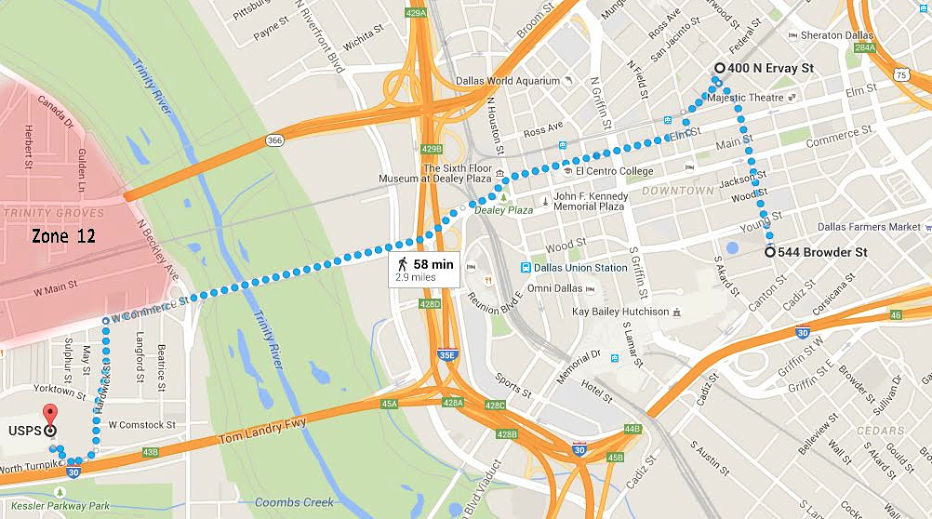
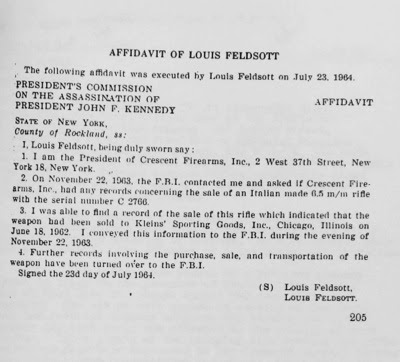


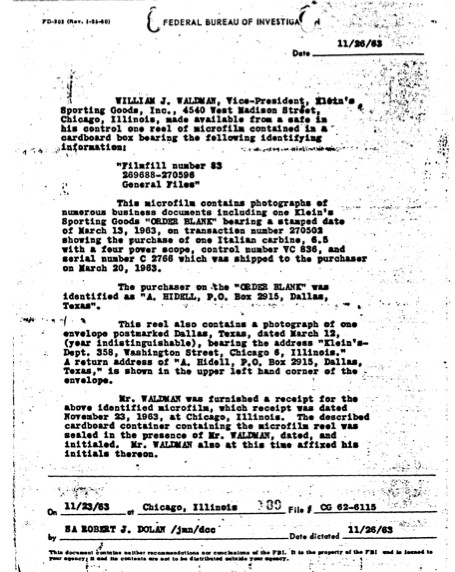



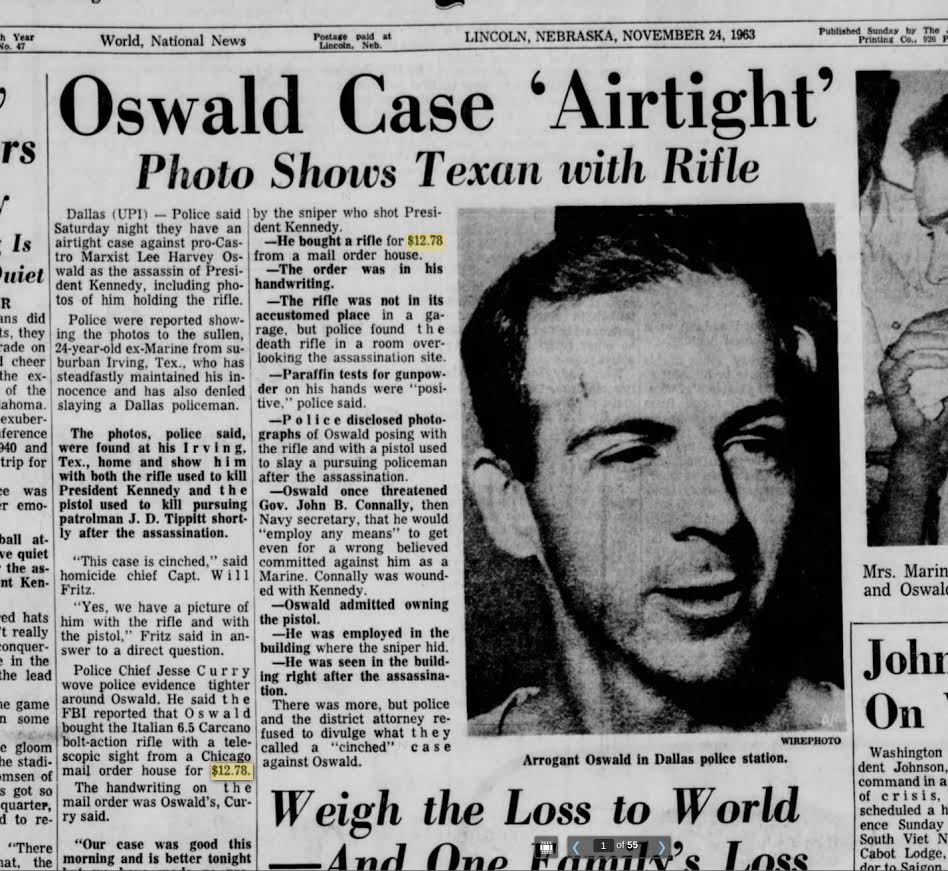
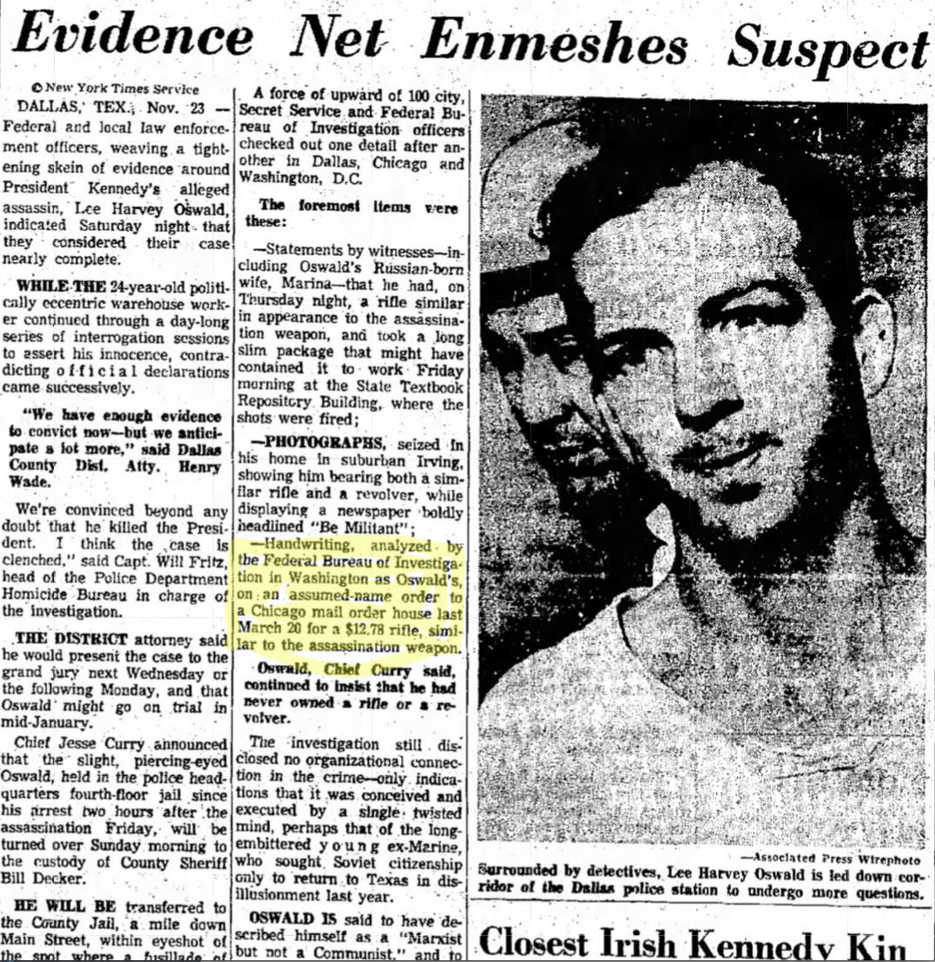
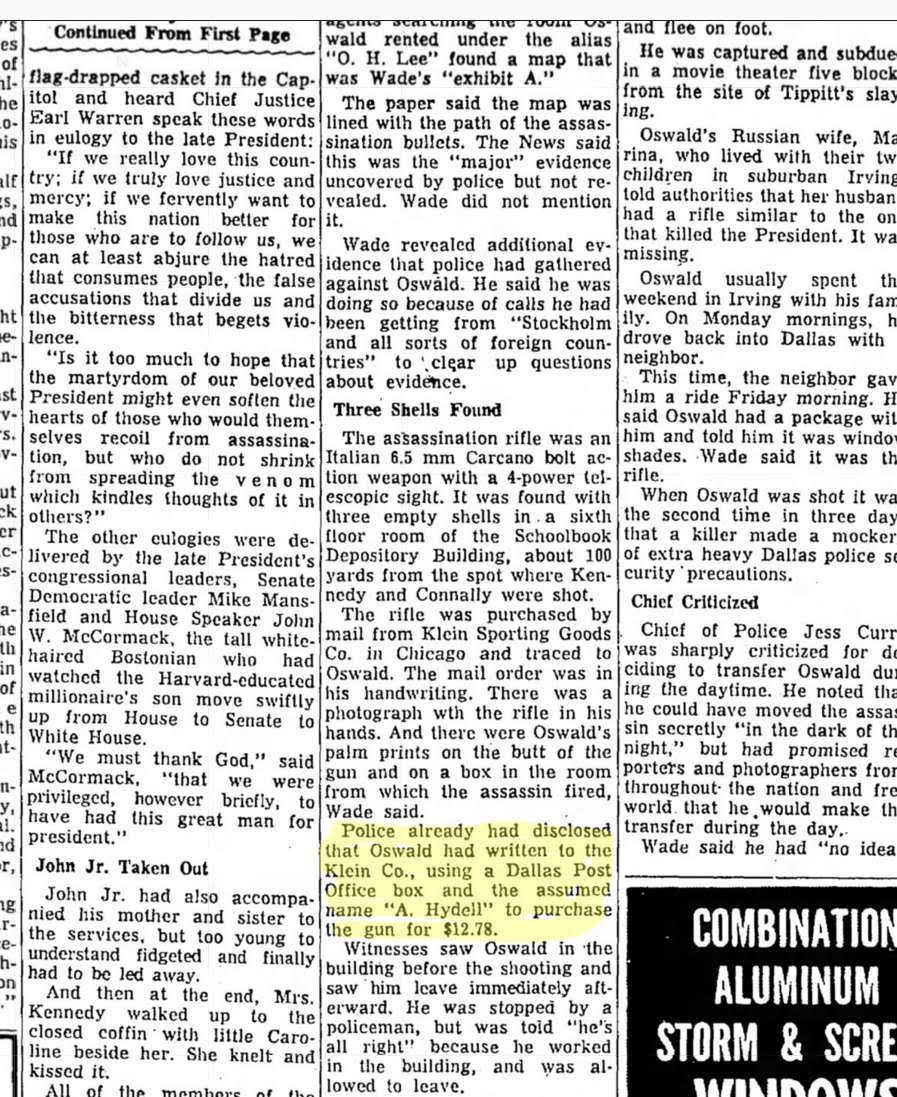
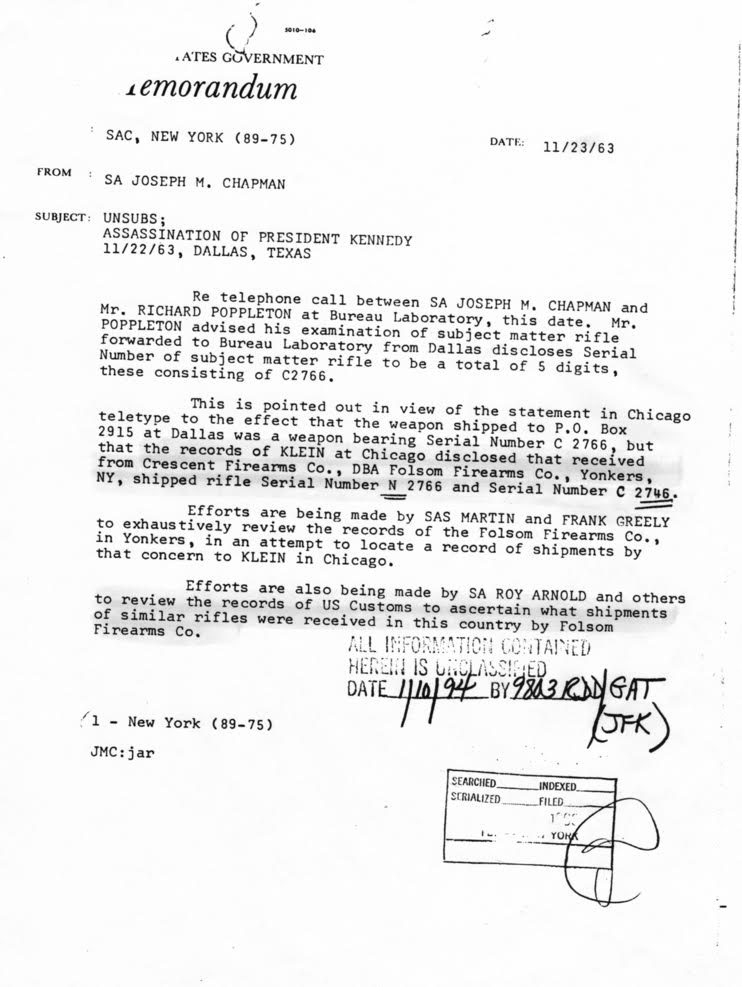
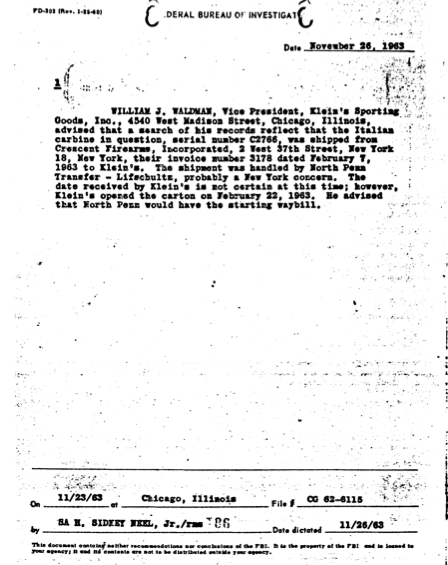
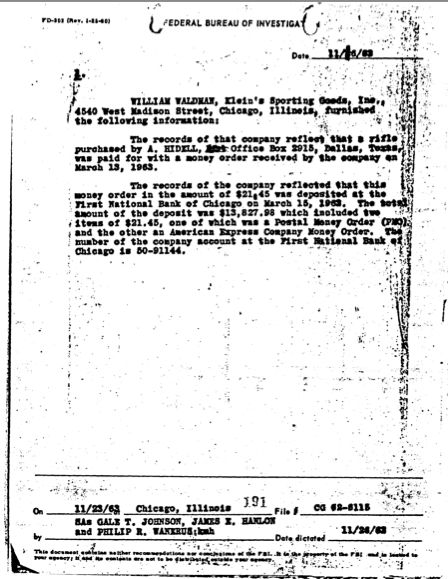

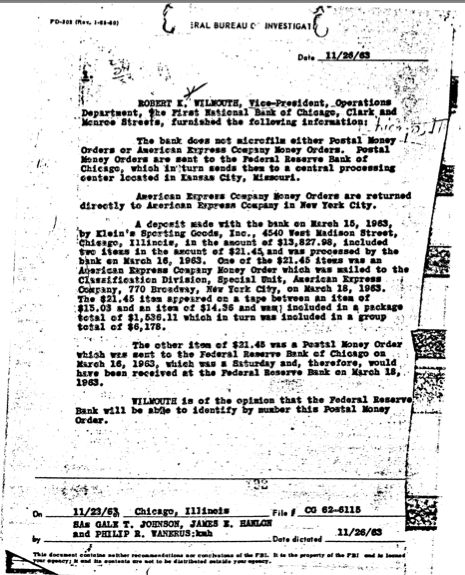
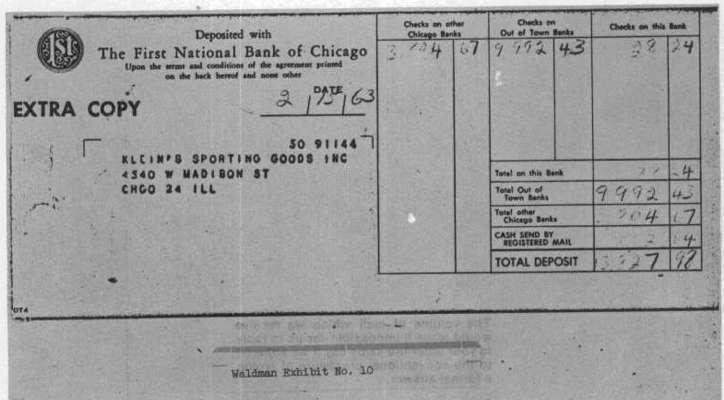
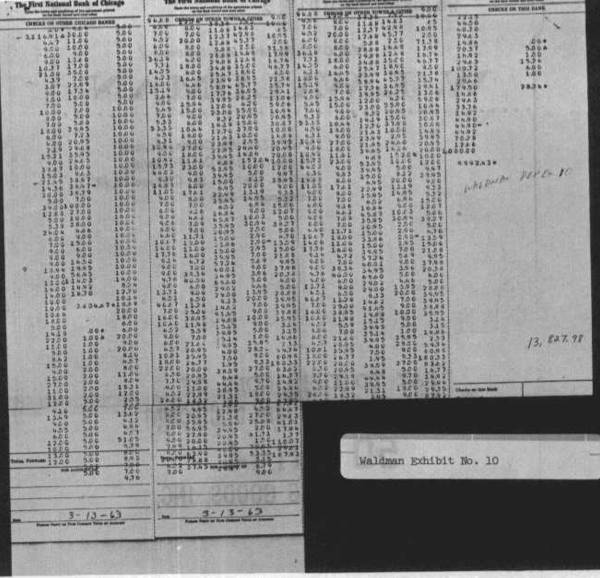
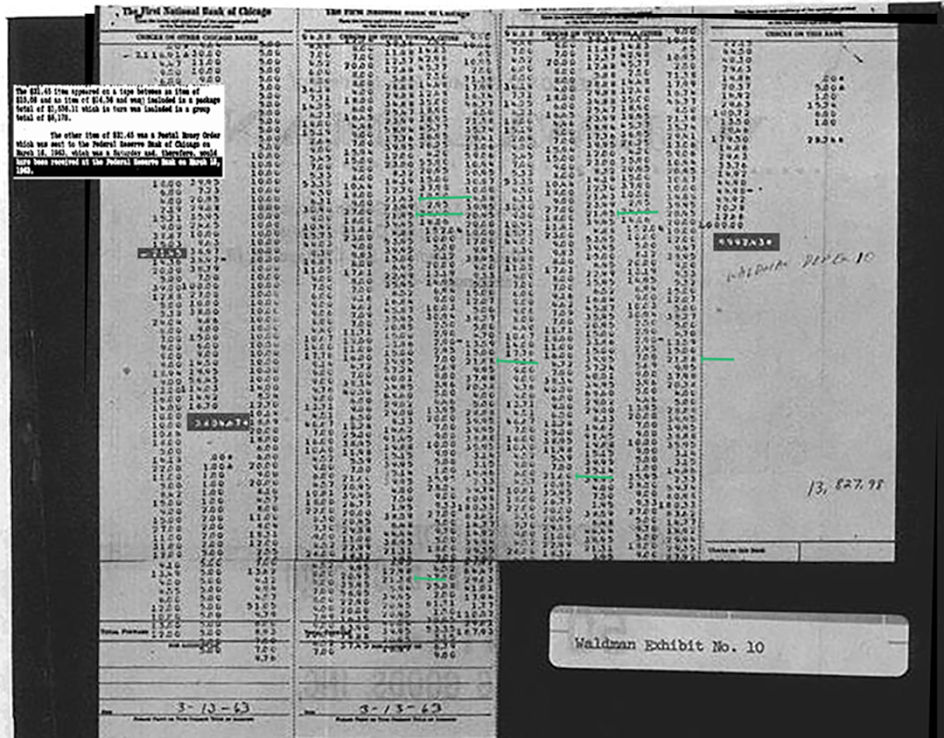

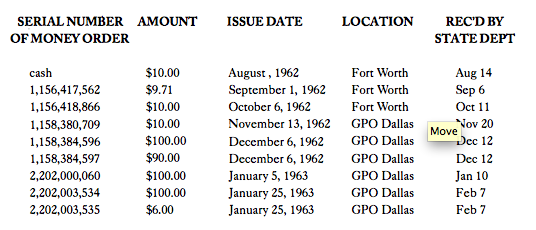
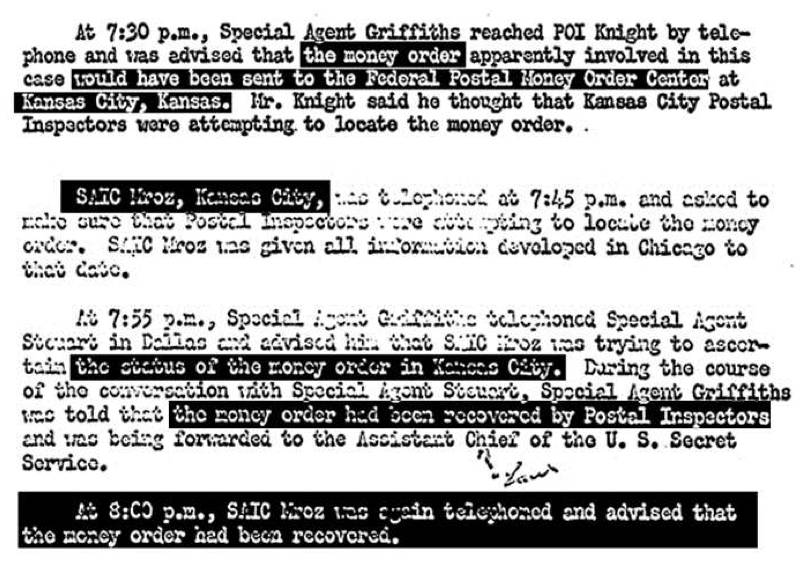



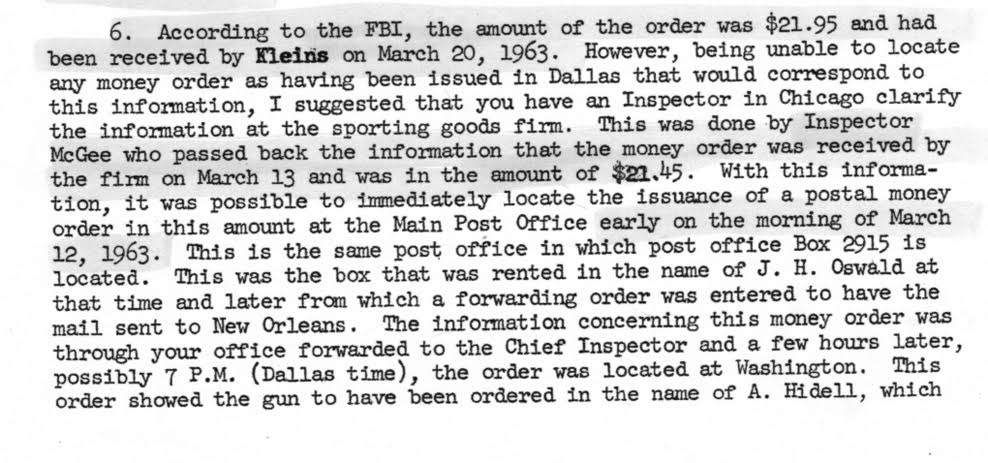

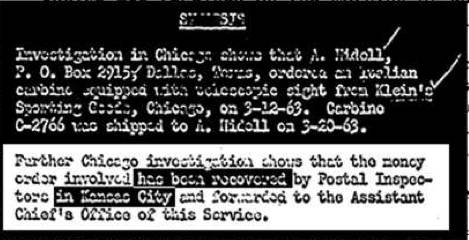
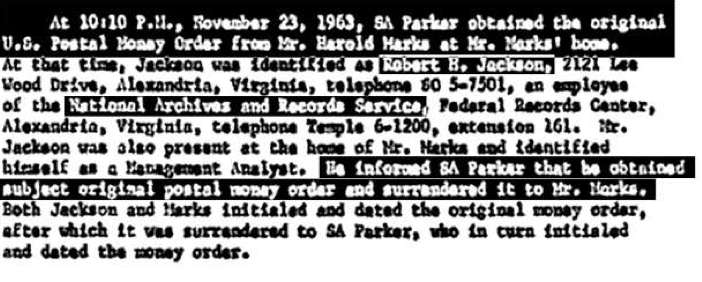

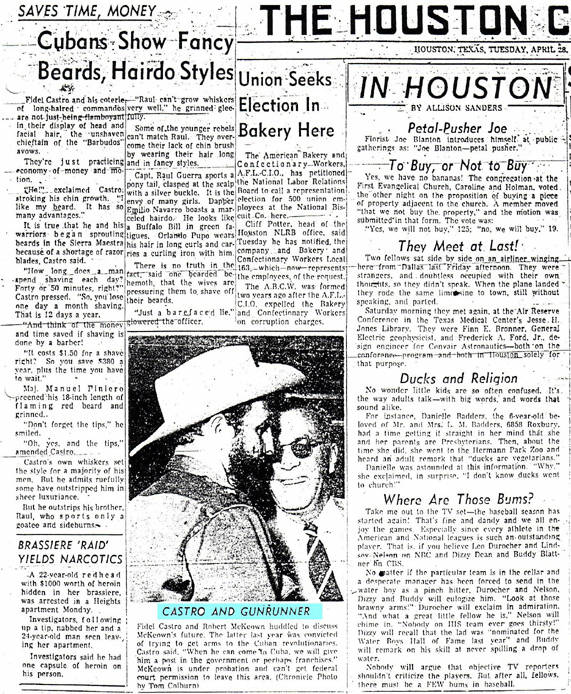

No comments:
Post a Comment
Note: Only a member of this blog may post a comment.